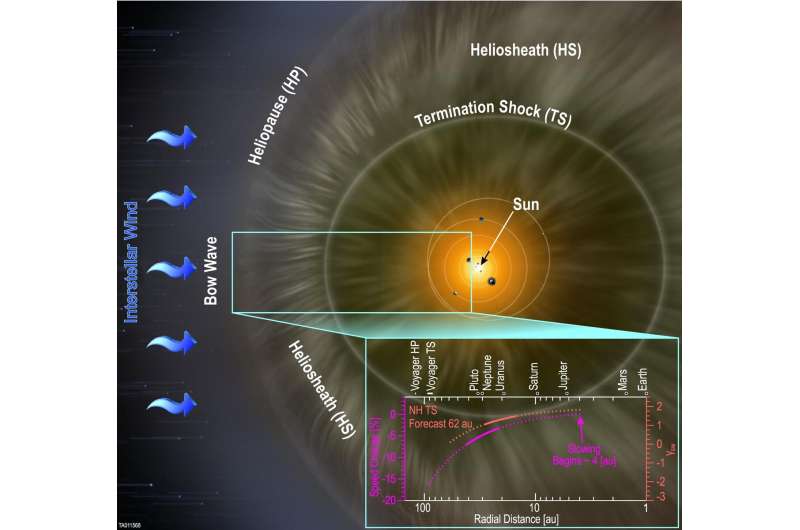Solar Wind Around Pluto instrument confirms solar wind slows farther away from the sun

Measurements taken by the Solar Wind Around Pluto (SWAP) instrument aboard NASA's New Horizons spacecraft are providing important new insights from some of the farthest reaches of space ever explored. In a paper recently published in the Astrophysical Journal, a team led by Southwest Research Institute shows how the solar wind—the supersonic stream of charged particles blown out by the Sun—evolves at increasing distances from the Sun.
"Previously, only the Pioneer 10 and 11 and Voyager 1 and 2 missions have explored the outer solar system and outer heliosphere, but now New Horizons is doing that with more modern scientific instruments," said Dr. Heather Elliott, a staff scientist at SwRI, Deputy Principal Investigator of the SWAP instrument and lead author of the paper. "Our Sun's influence on the space environment extends well beyond the outer planets, and SWAP is showing us new aspects of how that environment changes with distance."
The solar wind fills a bubble-like region of space encompassing our solar system, called the heliosphere. From aboard New Horizons, SWAP collects detailed, daily measurements of the solar wind as well as other key components called "interstellar pickup ions" in the outer heliosphere. These interstellar pickup ions are created when neutral material from interstellar space enters the solar system and becomes ionized by light from the Sun or by charge exchange interactions with solar wind ions.
As the solar wind moves farther from the Sun, it encounters an increasing amount of material from interstellar space. When interstellar material is ionized, the solar wind picks up the material and, researchers theorized, slows and heats in response. SWAP has now detected and confirmed this predicted effect.
The SWAP team compared the New Horizons solar wind speed measurements from 21 to 42 astronomical units to the speeds at 1 AU from both the Advanced Composition Explorer (ACE) and Solar TErrestrial RElations Observatory (STEREO) spacecraft. (One AU is equal to the distance between the Sun and Earth.) By 21 AU, it appeared that SWAP could be detecting the slowing of the solar wind in response to picking up interstellar material. However, when New Horizons traveled beyond Pluto, between 33 and 42 AU, the solar wind measured 6-7% slower than at the 1 AU distance, confirming the effect.
In addition to confirming the slowing of the solar wind at great distances, the change in the solar wind temperature and density could also provide a means to estimate when New Horizons will join the Voyager spacecraft on the other side of the termination shock, the boundary marking where the solar wind slows to less than the sound speed as it approaches the interstellar medium. Voyager 1 crossed the termination shock in 2004 at 94 AU, followed by Voyager 2 in 2007 at 84 AU. Based on current lower levels of solar activity and lower solar wind pressures, the termination shock is expected to have moved closer to the Sun since the Voyager crossings. Extrapolating current trends in the New Horizons measurements also indicates that the termination shock might now be closer than when it was intersected by Voyager. At the earliest, New Horizons will reach the termination shock in the mid-2020s. As the solar cycle activity increases, the increase in pressure will likely expand the heliosphere. This could push the termination shock to the 84-94 AU range found by the Voyager spacecraft before New Horizons has time to reach the termination shock.
New Horizons' journey through the outer heliosphere contrasts Voyager's in that the current solar cycle is mild compared to the very active solar cycle Voyager experienced in the outer heliosphere. In addition to measuring the solar wind, New Horizons' SWAP is extremely sensitive and simultaneously measures the low fluxes of interstellar pickup ions with unprecedented time resolution and extensive spatial coverage. New Horizons is also the only spacecraft in the solar wind beyond Mars (1.5 AU) and, consequently, the only spacecraft measuring interactions between the solar wind and the interstellar material in the outer heliosphere during the current mild solar cycle. New Horizons is on course to be the first spacecraft to measure both the solar wind and interstellar pickup ions at the termination shock.
"New Horizons has significantly advanced our knowledge of distant planetary objects, and it's only fitting that it is now also revealing new knowledge about our own Sun and its heliosphere," said New Horizons Principal Investigator Dr. Alan Stern of the SwRI.
The paper "Slowing of the Solar Wind in the Outer Heliosphere" by Elliott, D.J. McComas, E.J. Zirnstein, B.M. Randol, P.A. Delamere, G. Livadiotis, F. Bagenal, N.P. Barnes, S.A. Stern, L.A. Young, C.B. Olkin, J. Spencer, H.A. Weaver, K. Ennico, G.R. Gladstone, and C.W. Smith, was published November 11 in The Astrophysical Journal.
More information: Heather A. Elliott et al. Slowing of the Solar Wind in the Outer Heliosphere, The Astrophysical Journal (2019). DOI: 10.3847/1538-4357/ab3e49
Journal information: Astrophysical Journal
Provided by Southwest Research Institute


















